|
Thurs., August 2
THERE WILL BE NO ILC ALCPG PHYSICS AND DETECTOR R&D
SEMINAR THIS WEEK
2:00 p.m.
Computing Techniques Seminar - FCC1
Speaker: A. Iamnitchi, University of South Florida
Title: Filecules and Small Worlds in the DZero Workload: Characteristics and Relevance for Data Management
2:30 p.m.
Theoretical Physics Seminar - Curia II
Speaker: H. Nunokawa, Pontificia Universidade Católica do Rio de Janeiro
Title: Probing Non-Standard Neutrino Properties by Future Long-Baseline Oscillation Experiments
3:30 p.m.
DIRECTOR'S COFFEE BREAK - 2nd Flr X-Over
THERE WILL BE NO ACCELERATOR PHYSICS AND TECHNOLOGY
SEMINAR TODAY
Fri., August 3
3:30 - 6:30 p.m.
Labwide party - Atrium
THERE WILL BE NO JOINT EXPERIMENTAL-THEORETICAL PHYSICS
SEMINAR THIS WEEK
Click here for NALCAL,
a weekly calendar with links to additional information. |
Thursday, August 2
- Tomato Florentine
- *Grilled Chicken Cordon Bleu Sandwich
- Chimichangas
- Smart Cuisine
- Chicken Marsala
- Smoked Turkey Melt
- Assorted Slice Pizza
- SW Chicken Salad w/Roasted Corn Salsa
*Carb Restricted Alternative
Wilson Hall Cafe Menu |
|
Thursday, August 2
Dinner
- Asian Spring Rolls
- Grilled Seafood in Saffron Sauce
- Vegetable risotto
- Grilled Bananas w/Rum & Ice Cream
Wednesday, August 3
Lunch
- Salmon w/Shallot Sauce
- Pine Nut & Lemon Orzo
- Chocolate Cake w/Strawberries & Ice Cream
Chez Leon Menu
Call x4598 to make your reservation. |
|
|
GammeV turns spare parts into potential discovery tools

William Wester (left) and Aaron Chou stand next to the spare Tevatron magnet used in the GammeV experiment.
Aaron Chou, a Fermilab postdoc, usually spends his time working on cosmology research, but an intriguing result from a particle physics experiment in Italy sent him on a modern-day scavenger hunt. Talking to colleagues and looking around Fermilab for spare parts, Chou and William Wester, a scientist in the Particle Physics Department, joined forces and obtained the right equipment to build an experiment to search for an exotic new type of particle that is a billion times lighter than an electron. They are the co-leaders of the Gamma-to-milli-eV collaboration, a group of ten scientists.
The GammeV experiment uses a borrowed high-power laser and a spare Tevatron magnet that can be operated at Fermilab’s Magnet Test Facility to search for the ultra-light particle. The existence of such a particle was first suggested two years ago by an experiment, PVLAS, at the Legnaro National Laboratory in Italy. To find the necessary parts to test that experiment’s results, Chou and Wester went to an unusual place – the Fermilab cafeteria. “The Fermilab cafeteria is a wonderful place to talk to people and ask around for available equipment,” said Chou.
In the GammeV experiment, which cost about $30,000 to put together, scientists send a pulsed high-power laser beam through an opening in the powerful, superconducting magnet and into a mirror located halfway down the magnet. The expected result is that no photons--light particles--will be detected on the other side of the mirror. But if the new ultra-light particle exists, some of the photons will interact with the magnetic field and convert into the new particle, travel through the mirror, and then convert back into photons, which scientists would detect on the other side. GammeV collaborators expect to have results later this summer.
Scientists are skeptical about the new particle’s existence, but the results need to be checked, Chou said. “It’s unlikely but not impossible that the result is correct. If it is, it would be one of the most astounding discoveries of this century,” he said. “Such a discovery could fundamentally change the direction of future experimental research in particle physics. The potential scientific impact and the low cost of the experiment make this a no-brainer – it’s the type of experiment you just have to do.”
-- Amelia Williamson
|
Wood's Tea Company performs this Saturday
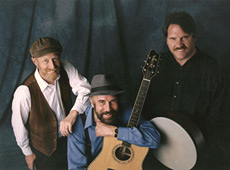
Wood's Tea Company
This Saturday, August 4, the Wood’s Tea Company will perform in Fermilab’s Ramsey Auditorium. From Celtic tunes to bluegrass, sea chanties and folk songs, the group performs a wide variety of music with equal ease and skill. The Vermont-based group draws on a wide variety of musical experience and expression. Band members employ as many as a dozen different instruments, from banjos, bezoukis, and bodhrans to guitars and tin whistles. Combining exceptional music skills with wit and humor, Wood’s Tea Company has entertained audiences across the United States.
Folk legend Woody Guthrie was an early inspiration for the band. “There was something about his music that bucked music establishment trends,” says band member Rusty Jacobs. “He was singing directly to the people and it appealed to us.” After building a solid reputation in New England, Wood’s Tea Company started touring on the concert circuit nationwide.
Tickets for this Fermilab Arts Series performance are $16, and $8 for ages 18 and under. The concert starts at 8 p.m.
More Information |
@home in Africa
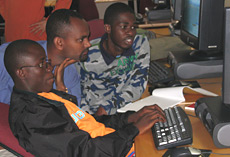
During last week’s hands-on AFRICA@home workshop African scientists installed servers and set up a new volunteer computing project. Image courtesy of AFRICA@home
Volunteer computing projects like SETI@home, Einstein@home and LHC@home are providing scientists with huge computing resources, donated by the public. So, imagine what African scientists could do if they could tap into the power of the millions of idle computers around the world.
Sounds crazy? In fact, this was the subject of a workshop held 16-22 July at the African Institute for Mathematical Sciences (AIMS) in Muizenberg, South Africa. The workshop's 35 participants came from 18 African countries and were selected from scores of applications.
Read More
|
From New Scientist
August 1, 2007
Neutrinos: The key to a theory of everything
When Heinrich Päs checked his email on 11 April this year, he was in for a surprise. Just months earlier, he had suggested that neutrinos - those ghostly subatomic particles that flit through the Earth as easily as raindrops through a spring sky - might have the ability to travel through time. Now he was getting a deluge of mail from fellow physicists pointing out the spooky similarity between his predictions and some experimental results published earlier that day.
The experiment, called Miniboone, was being run by a team of nearly 80 physicists at the Fermi National Accelerator Laboratory (Fermilab) at Batavia, Illinois - and the results presented a puzzle. They simply didn't match what everyone thought they knew about neutrinos, and in a quest for an explanation physicists were resorting to a variety of exotic ideas, time travel among them. But what really got physicists excited was the possibility that the findings could reveal a gap in the standard model of particle physics and point the way to a "theory of everything" that unites Einstein's general theory of relativity and quantum theory. "The mere idea of this makes you feel kind of funny," says Miniboone team member Janet Conrad of Columbia University in New York.
Read more
|
|
|
Looking at CP violation from another angle
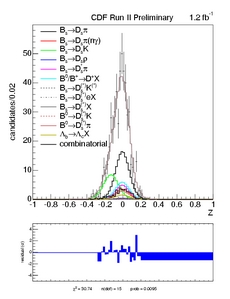
The figure shows the measured Bs → DsK signal (green) clearly separated from the mainly π-producing backgrounds. The plot below indicates in blue the difference between data and expectations including the newly
discovered Bs->DsK signal.
One of the most surprising features of nature is minute differences between the behavior of particles and antiparticles. These effects, called CP violation, have cosmic implications: we and most of the known universe are made of matter and not antimatter. Physicists have long been investigating CP violation, searching for clues to why CP violation in collider experiments is many orders of magnitude smaller than what is required to explain the absence of antimatter in our universe.
If the Standard Model of particle physics is correct, measurements of CP-violating processes can be expressed as side lengths and angles of the so-called "unitarity triangle". To check the validity of the Standard Model and to look for new signs of matter-antimatter symmetry, scientists measure the angles and sides in as many ways as possible, looking for discrepancies between the measurements and checking that the three sides and angles really form a triangle without gaps. One of the angles (γ) is currently not measured with high precision. A particular decay, of a Bs meson (consisting of a bottom and a strange quark) to a Ds meson (consisting of a charm and a strange quark) and a K meson (consisting of a strange and an up quark), could improve our knowledge of the angle γ.
The Bs → DsK decay is technically challenging because other previously observed processes dominate the data sample. Our measurement is the first to extract the Bs → DsK signal from these large backgrounds. It is now possible to look for CP violation in the Bs → DsK sample. Thus, we have taken the crucial first step towards using Bs → DsK decays for a measurement of γ and improving physicists' understanding of CP violation.
Learn More
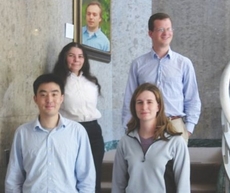
Pictured (left to right): Authors Hung-Chung Fang (UC Berkeley grad student), Marjorie Shapiro (UC Berkeley professor), Alessandro Cerri (CERN staff, formerly LBL postdoc), Amanda Deisher (UC Berkeley grad student), Johannes Mülmenstädt (UC Berkeley grad student).
Result of the Week Archive
|
Built from scratch
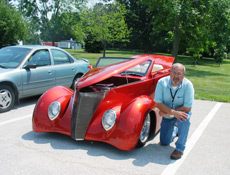
Yesterday, FESS Supervisor Herb Wyeth brought his custom 1937 Ford to the lab. Wyeth designed and built the car over 23 months in his home garage, constructing everything from the wide fenders to the frame and sloped windshield. After 30 years in the auto scene, Wythe has a number of 'muscle cars' to his credit. "I spend all of my free time on the cars. It sure beats watching TV," he said. Wythe plans to take his Ford, his first street rod creation, to more than 40 auto shows and cruise nights each year. He has already begun working on his next design. "Look for something completely different," he said.
-- J. Bryan Lowder
|
|
Shutdown safety discussion today
Members of the Electrical Safety Subcommittee invite employees involved in this year’s shutdown work to an open meeting on Thursday, August 2 at 11:00 a.m. in Curia II (WH2SW). Although all employees have received training, their may be questions about the principles of Lockout/Tagout and electrical safety, and this meeting will help explain the associated requirements. Attendance is not required but may be informative to the conduct of your particular work activities.
Today is an Air Pollution Action Day
The Partners for Clean Air and the Illinois Environmental Protection Agency have issued an Air Pollution Action Day notice for Thursday, Aug. 2. Check www.cleantheair.org for updates and tips on reducing impact.
Power outage on Monday, 7:00 a.m.
A sitewide power outage will take place on Monday morning from 7:00-7:30 a.m. Except for the Village and the Main Injector, the entire site will be without power. Please switch off computers and other equipment sensitive to power surges.
Friday: Cafeteria closes at 1 p.m.,
Users Center opens at 6:30 p.m.
Because of preparations for the labwide party, the Fermilab cafeteria will close on Friday, August 3, at 1 p.m. It will open again on Saturday morning. The Users Center will stay closed on Friday until 6:30 p.m.
Voluntary Supplemental Life Insurance:
Enrollment period ends Friday
Supplemental Life Insurance Enrollment packets have been sent to the mail stations of all employees eligible for supplemental life insurance coverage. Enrollment materials are also available on the Benefits Office website. The premium holiday has ended and new rates, effective September 1, will be charged for all supplemental life insurance coverage. Please take the opportunity to review your current coverage and make any necessary changes by the end of the enrollment period on August 3. Contact the Benefits Office if you have questions or need assistance completing your enrollment.
Wisconsin Dells Discount Book
The final day to purchase the Wisconsin Dells Coupon book is August 17. Books are still available in the Recreation Office and the discounts are good until April 1, 2008. The cost of the book is $20.
|
|